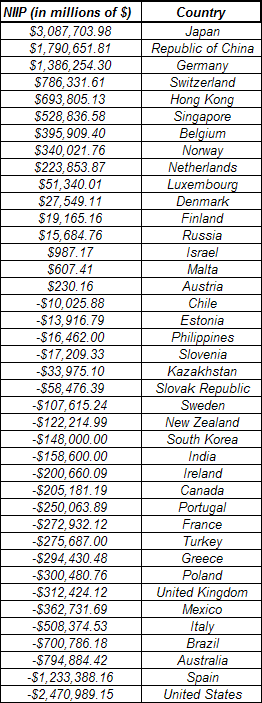Since 2006 The International Monetary Fund’s Balance of Payment statistics have been uploaded into a neat online database accessible through its website. Among country balance of payments figures, the database also features the “Net International Investment Position” of a country, which is defined as the difference between foreign assets that domestic residents own and domestic assets held by foreign entities. Here are the most recent (2010) rankings. Note that the 2011 rankings are still in the process of being calculated.
2010 Country NIIP (Net International Investment Position) statistics by the IMF. NIIP is defined by a country’s total domestically owned assets minus its foreign owned assets. All figures have been adjusted to nominal US dollars.

Source: IMF
It is no surprise that the most indebted country, the United States, takes the bottom of the list. Its NIIP means the value of its domestically owned assets is less than its liabilities to foreign investors. We see Spain, Greece, Italy, and Portugal on the list of negative NIIPers as well. Japan, China, and Germany are effectively the countries with the largest NIIP. Countries with a positive NIIP are considered to be creditor nations, while those with a negative NIIP are debtor nations. For everyday investors, the NIIP of a country promises to be a leading indicator of a country’s overall fiscal responsibility. Diversifying holdings in both creditor and debtor nations could help spread a portfolio’s risk over time.
Note that Germany and Switzerland have been acting as the main Eurozone creditors by maintaining a large and positive NIIP. Investors should keep the NIIP figures in mind when measuring the creditworthiness of a country and its businesses. Ultimately, the terms of trade will be determined by those nations that are willing to lend out their capital. Debtor nations will be the ones stuck with the credit card bill.
The charts below help visualize the countries with NIIPs that significantly stand out.
Stay on top of the markets with high-powered, in-depth audio interviews with industry insiders, financial and economic experts, book authors, and market strategists by subscribing to the Financial Sense Insider podcast. Click here for more information








